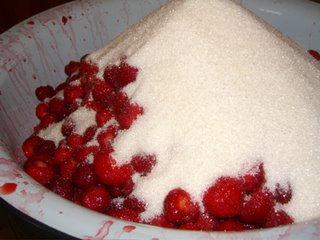

Just before leaving for vacation, I had an "opportunity" to can fruit for the winter. I use the quotation marks because though I may revel in the vacuum-sealed goodness come December, for my novice run it was a royal pain in the arse. But a confluence of events - Krista was just emerging from nearly a month holed up in the medical apartment (meaning I had access to its pristine kitchen and a partner in canning), I had a bundle of 1-liter jars I had requested from my computer class students, and the final crop of strawberries was upon us - presented a brief
window of opportunity so I took it.
This is a pretty common part of life in Moldova - people can food in the summer and fall when goods are cheap so they can eat well in the winter when they're more expensive. They make juices, jams, pickle things (which sadly include watermelon - yech!), and I think sometimes meat.
So let me tell you how it's done. First you buy the fruit - in our case 12kg of strawberries. Then wash and de-stem (which should be done by pulling the stem off with your fingers, not by cutting it off with a knife, which wastes a lot of strawberry). Then, if you're a local, you smother your pile of strawberries (which should be in a huge pot) with sugar on a one-to-one ratio. We opted for a less tooth-decay option of 7kg of sugar to 12kg of strawberries. Then you wait until all the sugar is absorbed. Next, you cook everything over a low flame. The amount of time here varies - I've heard everything from 40 minutes to 10 minutes a day for 3 days to a constant vigil of 24 hours of switching the stove off and on so the berries don't burn. I think we cooked them about 3 hours.
Now comes the fun/dangerous part of actually canning. To sterilize the cans, you should place them in a separate pot of boiling water. After they've been in there for a while, take them out and ladle your jam into them. Then place them standing up in another large pot of boiling water (ours was borrowed from the PC doc - it's basically a large metal cube). Let everything heat up and then pull out one can at a time to put the lid on. Incidentally, the lid should also be sterilized, but shouldn't be left in the boiling water too long because the rubber seal might deteriorate.
To seal the lid on the can, there's a special instrument that's basically a pipe-cutter. You place it on the top of the lid and keep spinning it around the edge. Each time you do so, a wheel presses a little further in on the sides of the lid until the seal is complete. Then turn the jar upside-down and allow to cool. As the air and jam inside the can cool, the molecules compress and thus, a vacuum is born.
Though I'm taking a humorous tack here, I should note that this was hard work. Carrying 30 pounds of strawberries from the market to the apartment, cleaning and de-stemming for several hours, stirring and monitoring the stove for several more, and using an instrument with a poorly designed grip to bend metal onto a jar that had only seconds before been sitting in boiling water is not exactly a recipe for relaxation. Of course, this didn't stop us from doing it all over again with 10kg of raspberries the next day.
Here are some things I learned:
1. Best to buy, wash, and cover the fruit with sugar on day 1 and let sit over night. Then on the morning of day 2 you can start cooking and canning.
2. Despite the cavities, it's probably better to use more sugar than we did. Our jam wound up being fairly watery, and I think more sugar would act as a coagulant. I suppose we could have also cooked everything for longer, but on such a low flame it would have taken forever to enough water to evaporate.
The end result was 8 liters of strawberry jam and another 8 liters of raspberry. I had fantasized that when I returned to America, I would can lots of things for the rest of my life - maybe give special holiday gifts of homemade jellies - but I think I'll content myself with buying the ready-made stuff off the supermarket shelf. That said, I am looking forward to doing this process all over again in September when tomatoes drop from 20 lei a kilo ($1.50) to 4 lei (20 cents). Gotta have my tomato sauce in the winter!
1 comment:
Dear Brad,
The secret ingredient is pectin which is a thickening agent.
Post a Comment